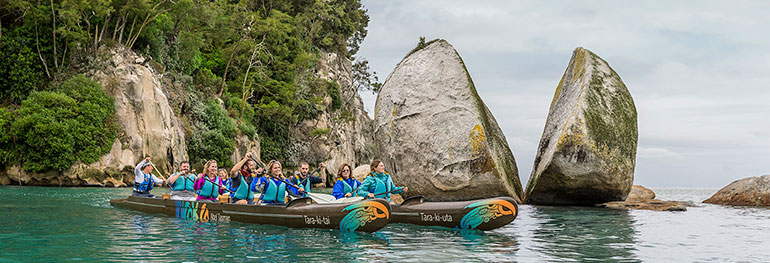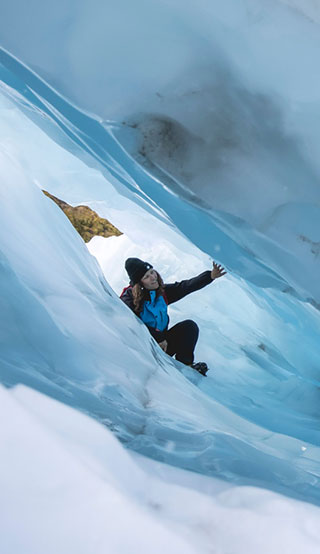The journey so far
On this page

Photo: Camilla Rutherford
Tourism’s Industry Transformation Plan (ITP) is one of eight ITPs active across Aotearoa New Zealand
ITPs were created when the Government committed to a policy which seeks to grow and transform industries with significant potential to contribute to a high-productivity, high-wage, low-emissions economy. All ITPs are created in partnership by the industry, unions, Māori, and government. Together, they set a long-term vision for transformative change through near- term actions.
The Ministry of Business, Innovation and Employment (MBIE) is the lead government agency for the Tourism ITP, supporting the Leadership Group through secretariat services.
The Tourism ITP is taking a phased approach
The Tourism ITP is taking a phased approach to the problems and opportunities in the industry, enabling a more focused approach to each phase. The first phase is the Better Work Action Plan - He Rautaki Tiaki Kaimahi (to care for people who work in our industry). The next phase will be focused on the environmental challenges and opportunities for tourism.
This draft action plan is a result of our thinking and partnership over the past 8 months
The Leadership Group has met 5 times since late 2021 to discuss workforce problems and opportunities, analyse the root causes of these problems, and think about future trends that will impact on the tourism workforce.
Coming out of these conversations, we have suggested a package of actions that we think will help address the problems and harness the opportunities. We have used the Te Reo Māori phrase ‘He Tirohanga Hou’ to describe the set of actions.
He Tirohanga Hou means a new outlook and ways of viewing or thinking. The use of the term Tirohanga Hou in this document refers to each of the eight ideas we have come up with to have a better outlook for the tourism workforce.
It recognises that our aim for this draft Action Plan is to identify new ideas tourism can pursue to reach to a better future.
This draft Action Plan sits within a rich ecosystem of other initiatives, and is informed by previous strategies
This Plan does not sit in isolation. It builds on and aligns with other government workstreams including the Government’s Employment Strategy and its seven supporting Employment Action Plans, other ITPs, the Innovation Programme for Tourism Recovery, the Reform of Vocational Education (including the formation of Regional Skills Leadership Groups, Workforce Development Councils and Te Pūkenga), the introduction of Fair Pay Agreements. This draft Action Plan builds on and aims to enhance existing work.
Innovation Programme for Tourism Recovery
Reform of Vocational Education(external link) — Tertiary Education Commission
As many will be aware, there are separate but related changes underway to our Immigration system. While these align with the strategic goals of the Better Work Action Plan, this draft Action Plan specifically does not include any recommendations regarding any such changes. The Immigration Rebalance, being led by the Minister of Immigration, aims to make it easier to attract and hire high-skilled migrants, while supporting some sectors to transition to more productive and resilient ways of operating, and to lessen reliance on low paid/waged migrants. The set of He Tirohanga Hou in this Action Plan will support tourism businesses by identifying ways they can attract and retain more skilled workers from both the domestic and international labour markets.
Rebalancing New Zealand’s Immigration System(external link) — New Zealand Immigration
The draft Action Plan also builds on the foundation of Go with Tourism, an initiative aimed at building Aotearoa New Zealand’s tourism and hospitality workforces by connecting great talent with quality employers and getting New Zealanders thinking positively about tourism and hospitality careers. Go with Tourism hosted a Workforce Wānanga at the end of 2021, bringing together: representatives from the industry, associations, educators, unions, students, local and central government to create solutions for the challenges facing the tourism and hospitality workforce.
Go with Tourism Workforce Wānanga 2021(external link) — Go with Tourism
The Wānanga has been an important input into the ideas covered in this draft Action Plan, especially the Tourism and Hospitality Accord.
Tourism and hospitality accord
We would also like to acknowledge and recognise the work of the New Zealand Tourism Futures Taskforce interim report: We are Aotearoa and the strong foundation it laid for many of the conversations we have had to date.
New Zealand Tourism Futures Taskforce
Defining the tourism industry
 MBIE defines tourism as a cross-cutting industry defined by the consumer, rather than goods or services that are consumed. Most other industries are defined by the products that are manufactured and sold. For example, the forestry sector is defined by wood products, and the fisheries sector is defined by seafood. For tourism, the definition is based on who is buying the goods or services. MBIE follows the United Nations World Tourism Organisation definition of tourism – “tourism is a social, cultural and economic phenomenon which entails the movement of people to countries or places outside their usual environment for personal or business/professional purposes.” Therefore ‘domestic tourism expenditure’ is any spending within New Zealand that occurs outside the purchaser’s usual environment (whether that is residence or place of work); regardless of what the goods or services are. As a result, tourism cuts across a multitude of sectors. Tourism spending is most prevalent in the activities, entertainment, accommodation, hospitality, transport, and retail sectors.
MBIE defines tourism as a cross-cutting industry defined by the consumer, rather than goods or services that are consumed. Most other industries are defined by the products that are manufactured and sold. For example, the forestry sector is defined by wood products, and the fisheries sector is defined by seafood. For tourism, the definition is based on who is buying the goods or services. MBIE follows the United Nations World Tourism Organisation definition of tourism – “tourism is a social, cultural and economic phenomenon which entails the movement of people to countries or places outside their usual environment for personal or business/professional purposes.” Therefore ‘domestic tourism expenditure’ is any spending within New Zealand that occurs outside the purchaser’s usual environment (whether that is residence or place of work); regardless of what the goods or services are. As a result, tourism cuts across a multitude of sectors. Tourism spending is most prevalent in the activities, entertainment, accommodation, hospitality, transport, and retail sectors.
The hospitality sector has featured prominently in our thinking about the tourism workforce. This is because hospitality represents a large proportion of the Tourism workforce and because there is data and evidence readily available in relation to the hospitality workforce.
The Tourism ITP did not set out to address the full range of the issues facing hospitality. However, we recognise that when it comes to the workforce, tourism and hospitality share many characteristics. Several of the Tirohanga Hou (new outlook, way of viewing and thinking) in this report will apply equally well to both. The Tourism and Hospitality Accord, for example, includes hospitality for that reason.
Defining regenerative tourism
A regenerative tourism system is one that leaves people, communities, and the environment better than it finds them, and can be understood as an extension of sustainability.
Regeneration occurs in systems that are healthy, thriving, and self-healing, in contrast to systems that continuously degrade and, as a result, become more vulnerable to shocks. A regenerative tourism system will inherently be more resilient than other systems.

